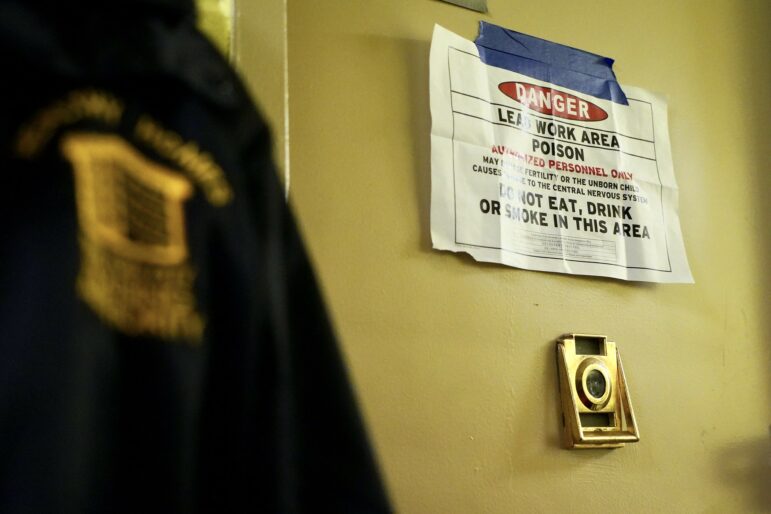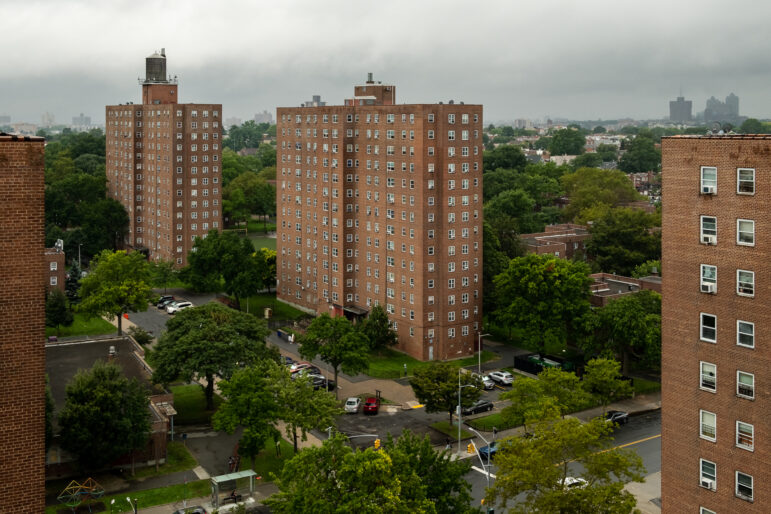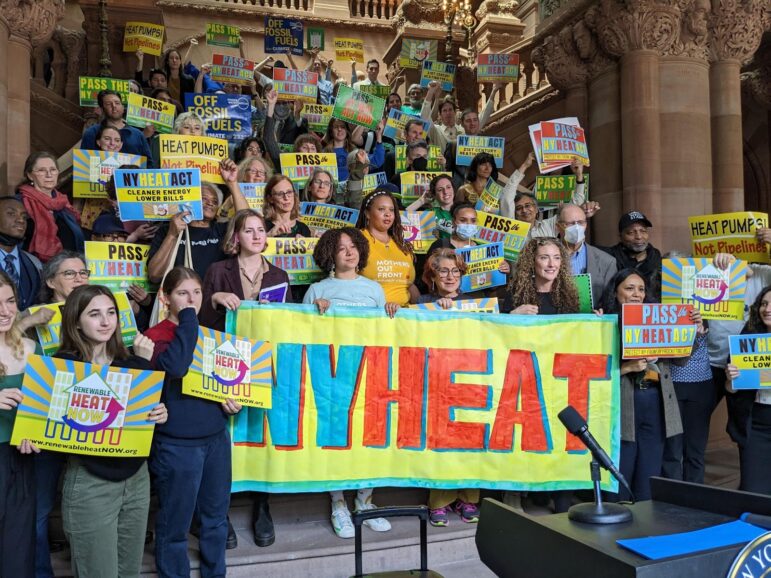The milestone, which includes an additional 3,000 units abated under the PACT program, signals progress after a 2019 agreement with the U.S. Department of Housing and Urban Development that requires the housing authority comply with federal lead protection laws.

Gerardo Romo / NYC Council Media Unit
A sign warning of lead abatement work underway in a NYCHA building in 2023.The New York City Housing Authority (NYCHA) is making strides in becoming lead-free after announcing Thursday that it has completed abatement work at more than 10,000 apartments over the last three years.
The housing authority marks the milestone after striking a 2019 agreement with the U.S. Department of Housing and Urban Development (HUD), which stated that NYCHA is to “comply with federal law protecting children from the hazards of lead poisoning.”
Lead, which was once used in paint because of its durability and quick dry times, is considered a toxin, particularly in children under the age of 6. Whether peeling chipped paint from a wall or inhaling dust, it can cause difficulties in learning and paying attention, according to the Centers for Disease Control and Prevention.
In 1960, the use of lead paint was banned in New York City and later prohibited on a federal level in 1978. Since a majority of housing developments were constructed prior to the ban, routine testing and removal of lead became crucial.
NYCHA has a rife history with lead requirements. A complaint filed in the U.S. District Court for the Southern District of New York in June 2018 stated that the housing authority had “routinely failed to comply with lead-based paint safety regulations,” according to the HUD Agreement.
And the city’s Department of Investigation (DOI) found that between 2013 and 2015, NYCHA filed false documents that claimed it was in compliance with inspection rules.
The HUD Agreement included stair-step suggestions to help NYCHA get on track with ensuring a healthy environment for residents. Within the first five years, abatement in all apartments in the Harlem River and Williamsburg Houses were to be completed. After 10 years, removals should be completed for 50 percent of all affected NYCHA residents, and 100 percent after 20 years—by Jan. 31, 2039.
So far, NYCHA stated that a “vast majority” of apartments at the Harlem River Houses and Williamsburg Houses have undergone abatement—85 percent and 100 percent respectively.
Currently, NYCHA’s Lead-Based Paint Abatement Program, in conjunction with the housing authority’s Healthy Homes Department, is testing 700 to 800 apartments each week, officials said.
In 2019, NYCHA’s goal was to test 134,000 apartments—the estimated number of units constructed before 1978.
Two years later, the city passed a stricter standard for lead content, from 1.0 milligrams per square centimeter to 0.5 milligrams per centimeter. Using the new standard, 10,000 public housing apartments have been abated since December 2021.

All NYCHA apartments, including those that do not have a child under 6 living there, will now be included in testing as of March under the new standard, according to NYCHA’s Final Agency Plan for Fiscal Year 2025. More than 86,000 apartments have been tested so far and as of Oct. 1, 48,000 of them tested negative, according to NYCHA.
The housing authority said it is abating 300 to 400 apartments a month, a “historic number for any landlord of this scale.” NYCHA’s Chief Executive Officer, Lisa Bova-Hiatt, said in a statement that the housing authority has “set course” for a lead-free NYCHA.
“And what’s to come from that commitment is a nationally recognized lead program that emphasizes thorough inspection and removal, supplemented by enhanced quality assurance protocols,” Bova-Hiatt said.
Ensuring apartments are free of lead is also one of the factors driving an uptick in apartment vacancies at NYCHA, housing officials have said previously.
While NYCHA has a 30-day target to turnaround vacant apartments, the most recent Mayor’s Management Report (MMR) listed the average time in fiscal year 2024 as 424.4 days. As of September, approximately 5,500 NYCHA units were vacant; another 596 were vacant but had new tenants selected to move in.
Some NYCHA units are in need of other extensive and time-consuming repairs. The average time a tenant lives in a NYCHA apartment is 25 years, which can stretch the amount of time it takes for an apartment to be turnkey ready for new residents.
The housing authority has a dedicated program—the Team for Enhanced Management, Planning and Outreach (TEMPO)—that inspects, remediates and relocates tenants if necessary as abatement work is being done. The team conducts periodic check-ins to see if a child under the age of 6 resides in the unit or at least spends 10 hours per week in the apartment.
To determine if an apartment has lead, the team uses an x-ray fluorescence (XRF) analyzer, a device used to determine what chemicals are present on a surface; they may also take dust or chipped paint samples.* A standard inspection takes no more than one hour and results are given by mail approximately 10 to 15 days later, according to NYCHA.
If abatement is necessary, all paint is fully removed. Tenants might be relocated to a hotel if removal is needed in kitchens, bathrooms or bedrooms. The average length of time for a relocation is 14 days, according to a NYCHA spokesperson.*
In addition to the 10,000 units counted at NYCHA, lead abatement work has also been completed at developments transferred to the Permanent Affordability Commitment Together (PACT) program. PACT, which converts traditional public housing units from the Section 9 model to the Project-Based Section 8 federal program, has more than 38,000 apartments in its portfolio. Of that set, 3,000 are lead-free, according to NYCHA.
Councilmember and chair of the Committee on Public Housing, Chris Banks, said in a statement that he is looking forward to more progress in the coming years.
“While the 10,000 units in traditional NYCHA Section 9 buildings and 3,000 units is buildings that are part of the PACT-RAD program represent a step in the right direction of correcting NYCHA’s decades-long problem of making all NYCHA campuses lead free, there is still much work to be done,” said Banks.
*This story has been updated with additional information from NYCHA about its testing and lead abatement processes.
To reach the reporter behind this story, contact Tatyana@citylimits.org. To reach the editor, contact Jeanmarie@citylimits.org
Want to republish this story? Find City Limits’ reprint policy here.









